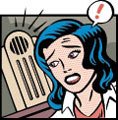Introduction to classical music # 4: versions, opus 3.
To conclude these entries about versions, I would like to speak to you about two other methods which make it possible to determine the quality of a recordings in classical music: in store listening and, finally, the famous method which is, in my opinion, the most effective.
It is always pleasant to be in the classical music section of a big record store, among salesmen and listening posts. But even if qualified salesmen and the fact of being able to hear music on the spot are major assets, I would like here to underline some of their disadvantages.
 First of all, in store listening only makes it possible to listen to extracts, and for a short period of time. Not only is it often impossible to make a fast-forward through the recording with listening posts, but it is not the most comfortable setting. Also, it is highly improbable that they will let you listen to 9 or 10 different recording of the same music, because no record dealer has to unpack all the CD's they have in stock for you.
First of all, in store listening only makes it possible to listen to extracts, and for a short period of time. Not only is it often impossible to make a fast-forward through the recording with listening posts, but it is not the most comfortable setting. Also, it is highly improbable that they will let you listen to 9 or 10 different recording of the same music, because no record dealer has to unpack all the CD's they have in stock for you. In fact, I think that in store listening is useful especially when you want to make sure that the title of music you have in your head or on a small piece of paper is the right one.
These disadvantages are about the same ones when you shop for classical music online, like the iTunes Music Store or at Naxos’ site, where it is only possible to hear extracts.
A small note here about salesmen: don't forget that a good salesman can often give the impression that he knows more than what he really knows. If you allow me one advice on the subject: the best way is to often discuss with the salesmen; then, when you find the most qualified one, always refer to him. The more that salesman will get to know your tastes, the more honest and open he will be.
 Finally, there is, in my opinion, a way of determining the ultimate version of a classical recording which is the best: first impression. I'm talking here about this particular moment when your hear for the first time a classical piece, that moment when the music literally grabs you. And that will happen to you if you open your ears, I promise! And, ideally, take note of the details for the recording that made you liked the music in question, because it is this version - and only this version - that will give you the same pleasure in listening over and over.
Finally, there is, in my opinion, a way of determining the ultimate version of a classical recording which is the best: first impression. I'm talking here about this particular moment when your hear for the first time a classical piece, that moment when the music literally grabs you. And that will happen to you if you open your ears, I promise! And, ideally, take note of the details for the recording that made you liked the music in question, because it is this version - and only this version - that will give you the same pleasure in listening over and over. Therefore, in my opinion, the ultimate version of a classical music recording is a matter of luck. This fortunate coincidence usually occurs when you are browsing in a music store when the salesmen play a disc which will make you look up ; it can also occur when listening to a few minutes of classical music on the radio, or when you are with a friend or a relative to whom you asked to listen to his best classical recordings.
Because classical music, like all other kinds of music, is all about emotions...
By the way, essential information to jolt down for a classical music recording are the name of the conductor, the name of the orchestra, as well as the names of the interpreters, if it is a concerto or a vocal piece.
So, next time, I will talk about classical music labels and the wonderful world of disc jackets.
See you next time!




